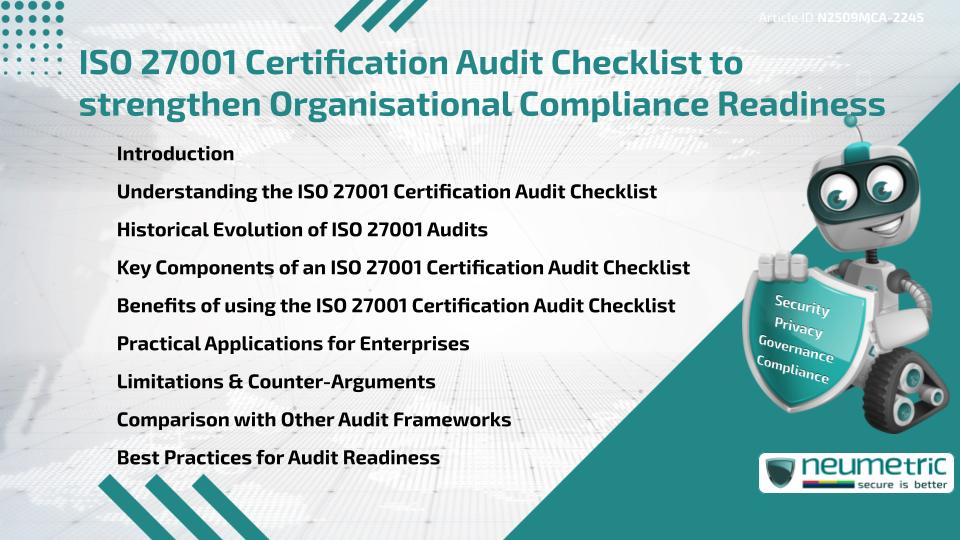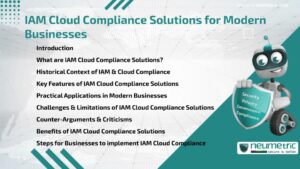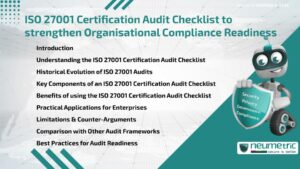Table of Contents
ToggleIntroduction
An ISO 27001 Certification Audit checklist is a valuable tool for organisations seeking to strengthen compliance & readiness for certification. ISO 27001 defines the requirements for an Information Security management system & audits verify whether enterprises meet those requirements. The checklist ensures that all necessary controls, documents & processes are in place before an Audit begins. By following the ISO 27001 Certification Audit checklist, organisations can reduce errors, increase efficiency & improve their chances of achieving Certification successfully.
Understanding the ISO 27001 Certification Audit Checklist
The checklist acts as a roadmap for enterprises preparing for Certification audits. It covers documentation, Policies, procedures, controls & management practices required by ISO 27001. Unlike informal reviews, the ISO 27001 Certification Audit checklist ensures a systematic & comprehensive Assessment of readiness. It allows enterprises to identify gaps, implement Corrective Actions & align with Best Practices before Auditors arrive.
Historical Evolution of ISO 27001 Audits
ISO 27001 originated from the British Standard BS 7799, which evolved into a globally recognised Framework for Information Security. As Certification became more widespread, the need for structured audits grew. Over time, auditors developed detailed checklists to guide assessments & ensure consistency across organisations. Today, the ISO 27001 Certification Audit checklist reflects both international standards & practical Audit experience, making it a trusted resource for enterprises worldwide.
Key Components of an ISO 27001 Certification Audit Checklist
A typical checklist includes several essential components:
- Verification of an established Information Security management system.
- Documentation of scope, Policies & objectives.
- Risk Assessment & treatment plans.
- Implementation of Annex A Security Controls.
- Evidence of management reviews & internal audits.
- Training & awareness programmes for Employees.
- Incident management & continual improvement processes.
These elements ensure that Auditors can confirm compliance with every requirement of ISO 27001.
Benefits of using the ISO 27001 Certification Audit Checklist
Enterprises that use the checklist benefit in multiple ways:
- Improved organisation & clarity during Audit preparation.
- Early identification of compliance gaps.
- Reduced stress & uncertainty during audits.
- Stronger confidence in achieving certification.
- Enhanced alignment of security practices with business goals.
The ISO 27001 Certification Audit checklist therefore acts as both a Compliance Tool & a management aid.
Practical Applications for Enterprises
Organisations apply the checklist by conducting internal audits, preparing documentation & validating Evidence before the official Audit. For example, a Finance company may use the checklist to confirm that Access Controls are in place, Incident Response procedures are tested & Risk registers are up to date. By adopting this structured approach, enterprises can demonstrate proactive compliance & avoid delays or failures during certification.
Limitations & Counter-Arguments
While highly effective, the checklist is not without challenges. Some critics argue that enterprises may focus too heavily on completing the checklist rather than building a strong security culture. Others suggest that smaller organisations may struggle with the time & resources required to implement every checklist item. Additionally, checklists may not capture all the nuances of an organisation’s specific Risk environment. This means the checklist should be used as a guide rather than a substitute for tailored Risk Management.
Comparison with Other Audit Frameworks
The ISO 27001 Certification Audit checklist is often compared with tools used in ISO 9001 or ISO 22301 audits. While these frameworks focus on Quality Management & Business Continuity, ISO 27001 uniquely addresses Information Security Risks. Unlike NIST CSF or COBIT, which provide broader guidance, ISO 27001 is certification-based, requiring detailed Evidence. This makes the checklist particularly valuable for organisations that must demonstrate compliance through external certification.
Best Practices for Audit Readiness
To maximise success, enterprises should follow Best Practices when using the ISO 27001 Certification Audit checklist:
- Start preparation early & review progress regularly.
- Engage leadership to ensure accountability & resource support.
- Conduct internal audits & mock assessments.
- Train Employees at all levels on their compliance responsibilities.
- Document Evidence clearly & maintain version control.
These practices help organisations streamline the Audit process & improve compliance maturity.
Takeaways
An ISO 27001 Certification Audit checklist provides organisations with a structured approach to preparing for Certification audits. While not a substitute for building a strong security culture, it ensures readiness, reduces Risks of non-compliance & strengthens organisational confidence.
FAQ
What is an ISO 27001 Certification Audit checklist?
It is a structured tool that helps organisations prepare for ISO 27001 Certification audits by ensuring all requirements are addressed.
Why is the checklist important?
It improves Audit readiness, identifies gaps & increases the Likelihood of successful certification.
Does the checklist guarantee certification?
No, it is a preparation tool, but successful Certification depends on effective implementation of ISO 27001 requirements.
Can small organisations use the checklist?
Yes, but they may need to adapt it to suit their resources & specific Risk environments.
How does the checklist differ from an Internal Audit?
An Internal Audit assesses overall compliance, while the checklist ensures that every required document & process is ready for review.
How often should the checklist be used?
Enterprises should use it regularly, especially before Internal & External Audits, to maintain compliance readiness.
Is the checklist applicable globally?
Yes, as ISO 27001 is an international standard, the checklist is relevant across industries & countries.
Need help for Security, Privacy, Governance & VAPT?
Neumetric provides organisations the necessary help to achieve their Cybersecurity, Compliance, Governance, Privacy, Certifications & Pentesting needs.
Organisations & Businesses, specifically those which provide SaaS & AI Solutions in the Fintech, BFSI & other regulated sectors, usually need a Cybersecurity Partner for meeting & maintaining the ongoing Security & Privacy needs & requirements of their Enterprise Clients & Privacy conscious Customers.
SOC 2, ISO 27001, ISO 42001, NIST, HIPAA, HECVAT, EU GDPR are some of the Frameworks that are served by Fusion – a SaaS, multimodular, multitenant, centralised, automated, Cybersecurity & Compliance Management system.
Neumetric also provides Expert Services for technical security which covers VAPT for Web Applications, APIs, iOS & Android Mobile Apps, Security Testing for AWS & other Cloud Environments & Cloud Infrastructure & other similar scopes.
Reach out to us by Email or filling out the Contact Form…





